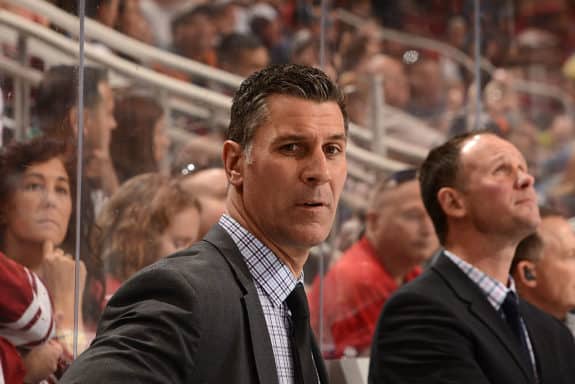The Colorado Avalanche made some key shifts which helped them beat the Toronto Maple Leafs in their own arena. For a struggling Avalanche team, those changes could signal better days ahead for the Colorado faithful.
The Avalanche struggled through December, grappling to eke out points against other frustrated teams. They returned from Christmas break and started playing better but they still weren’t getting the wins. So how did the Avalanche find a way to win against a talented Toronto roster?
The Return of the Injured
Two key players returned from injury. Forward Colin Wilson made it back in time to play on the fourth line against the Montreal Canadiens. He played limited minutes in a sheltered role that game and had minimal impact. Wilson brings a gritty presence to the ice and is willing to battle in the corners and along the boards. In his second outing, he played an additional three minutes in an upgraded role.

Nikita Zadorov announced his return from injury with authority against Toronto. The big Russian defenseman who had been relegated to the third pairing and averaging 15 minutes on ice prior to injury made his presence known. In 20 minutes of ice time, Zadorov accumulated seven hits, took four shots on goal, was called for two penalties and blocked a shot.
He opened up the ice and made players pay for skating down his side of the rink. He also pinched in at timely moments, helping to keep the puck in the offensive zone. He used his big body to his advantage and helped the Avalanche control play.
Between Wilson and Zadorov, the Avalanche added two physical players who played their game well. And it opened up chances for the Avalanche to score while also limiting shots allowed.
Coach Bednar Changed up Lines
Coach Bednar changed up the forward lines aside from the Avalanche’s top line of Nathan MacKinnon, Gabriel Landeskog and Mikko Rantanen against the Maple Leafs.
The aforementioned Wilson joined workhorse center Carl Soderberg on the ‘second’ line (used loosely as even the coach says he doesn’t consider the lines ranked as two through four) and J.T. Compher joined the line as well. Up until Monday night, Soderberg had played almost exclusively with Matt Nieto and Matt Calvert. The shift to new personnel added more physical wingers to match Soderberg’s effective two-way play. It made a difference as the line pushed the play all night. And, in case you missed it, the shift paid off big time.

Soderberg earned the first hat trick of his NHL career, including a spectacular shorthanded goal to propel the Avalanche to their first lead in the game with a little over five minutes remaining in the second period. His new linemates earned assists on his second goal while defenseman Ian Cole notched an assist on his empty0net goal to seal the win with less than two minutes remaining in the game. It’s worth noting Soderberg didn’t play a lot of extra minutes either. He just had more complementary players working together to push the play. And it made a difference.
Calvert and Nieto joined center Alexander Kerfoot on the ‘third line.’ While Calvert and Nieto logged nearly the same amount of time on ice, they both shone on the penalty kill, which didn’t allow a goal. The hard work eventually paid off for Calvert as he banked a shot off the boards into an empty net to put the Avalanche up 5-3 with three minutes remaining. The shifting line combinations helped the secondary scoring as they accounted for four of the Avalanche’s six goals.
The Coach Shifted Strategy
Perhaps the biggest change, though, came from the team’s strategy. The Avalanche have relied heavily on the drop pass when either on the man advantage or when offensive opportunities opened up. In the first period, they ignored the drop pass for a full-court press through the neutral zone, utilizing short, quick passes to distribute the puck as three to four players moved through the neutral zone towards Toronto’s net.

It was a thing of a beauty and it caught the Maple Leafs off guard. There’s nothing wrong with the occasional drop pass but the Avalanche relied on it almost exclusively and other teams around the league have been ruling it out as well. It lost its novelty and teams made adjustments. The Avalanche hadn’t and were getting penned in their own end even when on a power play, until last night.
That’s not to say Colorado didn’t try the drop pass. They ran it out on their second power play to ill effect, keeping the first power play unit from getting a single shot on net.
For the coaches to run out a different strategy is a huge deal for a staff that’s been reluctant to make tactical changes. The shift addresses one of the biggest concerns over the last six weeks – will the coaches ever change tactics? Teams have studied the Avalanche and adapted for some of their game plan. Yet, Colorado hadn’t seemed to make any adjustments themselves. If the coaches are willing to shift strategies after all, the Avalanche can go far.
Average Goaltending Helped
The Avalanche benefited from one other improvement. Goaltending was adequate. Semyon Varlamov made a couple of great saves early on to keep Toronto off the scoreboard in the first period. However, he did eventually surrender three goals. His final save percentage was .850, having stopped 17 of 20 shots. But if the Avalanche had that kind of performance against the Calgary Flames or Winnipeg Jets, they might have gotten a win or two, or at least a point.

The Avalanche aren’t out of the woods yet. They got a win and stopped the bleeding. Now they need to prove they can build from this point and string a couple of wins together. Beating Toronto and shifting a few key elements opened up the door of hope. There are promising possibilities on the horizon if the Avalanche can seize the moment and fight through the door. They have four games before the All-Star break and their bye week. It’s up to the Avalanche to show they can build on their success.